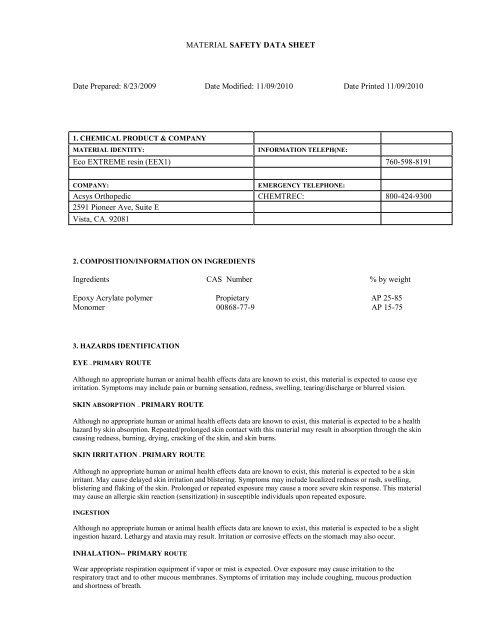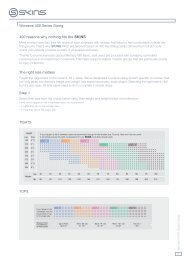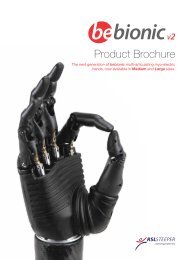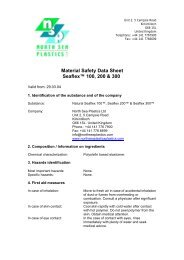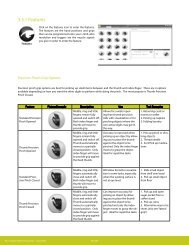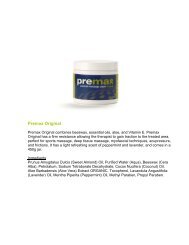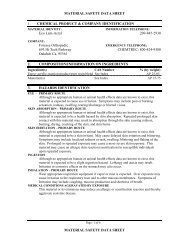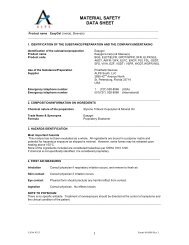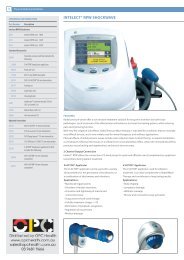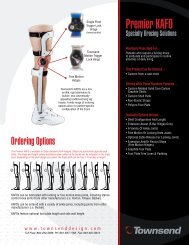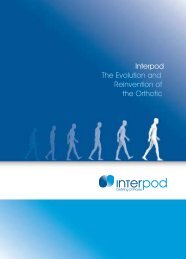Eco Extreme Resin MSDS - OPC Health
Eco Extreme Resin MSDS - OPC Health
Eco Extreme Resin MSDS - OPC Health
- No tags were found...
You also want an ePaper? Increase the reach of your titles
YUMPU automatically turns print PDFs into web optimized ePapers that Google loves.
MATERIAL SAFETY DATA SHEETDate Prepared: 8/23/2009 Date Modified: 11/09/2010 Date Printed 11/09/20101. CHEMICAL PRODUCT & COMPANYMATERIAL IDENTITY:INFORMATION TELEPH(NE:<strong>Eco</strong> EXTREME resin (EEX1) 760-598-8191COMPANY:EMERGENCY TELEPHONE:Acsys Orthopedic CHEMTREC: 800-424-93002591 Pioneer Ave, Suite EVista, CA. 920812. COMPOSITION/INFORMATION ON INGREDIENTSIngredients CAS Number % by weightEpoxy Acrylate polymer Propietary AP 25-85Monomer 00868-77-9 AP 15-753. HAZARDS IDENTIFICATIONEYE -- PRIMARY ROUTEAlthough no appropriate human or animal health effects data are known to exist, this material is expected to cause eyeirritation. Symptoms may include pain or burning sensation, redness, swelling, tearing/discharge or blurred vision.SKIN ABSORPTION —PRIMARY ROUTEAlthough no appropriate human or animal health effects data are known to exist, this material is expected to be a healthhazard by skin absorption. Repeated/prolonged skin contact with this material may result in absorption through the skincausing redness, burning, drying, cracking of the skin, and skin burns.SKIN IRRITATION --PRIMARY ROUTEAlthough no appropriate human or animal health effects data are known to exist, this material is expected to be a skinirritant. May cause delayed skin irritation and blistering. Symptoms may include localized redness or rash, swelling,blistering and flaking of the skin. Prolonged or repeated exposure may cause a more severe skin response. This materialmay cause an allergic skin reaction (sensitization) in susceptible individuals upon repeated exposure.INGESTIONAlthough no appropriate human or animal health effects data are known to exist, this material is expected to be a slightingestion hazard. Lethargy and ataxia may result. Irritation or corrosive effects on the stomach may also occur.INHALATION-- PRIMARY ROUTEWear appropriate respiration equipment if vapor or mist is expected. Over exposure may cause irritation to therespiratory tract and to other mucous membranes. Symptoms of irritation may include coughing, mucous productionand shortness of breath.
Page: 3 of 5Date Prepared: 8/23/2009 Date Modified: 11/09/2010 Date Printed 11/09/2010spreading fire, increasing risk of bums/injuries. Water may be ineffective in firefighting due to low solubility. Usewater spray/fog for cooling. Pressure relief system may plug with solids, increasing risk of overpressure. Notifyauthorities if liquid enters sewer/public waters.6. ACCIDENTAL RELEASE MEASURESSpilled or released material may polymerize and release heat/gases. Extinguish all ignition sources andventilate area. Wear protective equipment during clean up. Dike and recover large spill. Soak up smallspill with inert solids (such as vermiculite, clay) and sweep/shovel into vented disposal container. Washspill area with a strong detergent and water solution; rinse with water but minimize water use during cleanup. For spills on water, contain, minimize dispersion and collect. Dispose/report per regulatoryrequirements.7. HANDLING AND STORAGEUnless inhibited, product can polymerize, raising temperature and pressure, possibly rupturing container.Check inhibitor content often, adding to bulk liquid if needed. Do not blanket or mix with oxygen-free gasas it renders inhibitor ineffective. Do not store at below 32F — inhibitor can separate as a solid. If frozen,warm and remix material gently (
Page: 4 of 5Date Prepared: 8/23/2009 Date Modified: 11/09/2010 Date Printed 11/09/20109. PHYSICAL AND CHEMICAL PROPERTIESBoiling Point198C/40F (82C @ 3mbar)Vapor Pressure.23 mm Hg @ 67CVapor Density (air=1) >1Specific Gravity (water=1 @39.2F)AP 1.32 @ 25C/77FPercent VolatilesNegligibleEvaporation Rate (Bac= 1)N/DAViscosity Units, Temp. (Brookfield) Varies@ 25C/77FOdorMild to sweet acrylic odorpHN/DAColorStraw to light yellowStateviscous liquid10. STABILITY AND REACTIVITYCONDITIONS AND MATERIALS TO AVOIDHigh temperatures, localized heat sources (i.e., drum or band heaters), oxidizing conditions, freezing conditions, directsunlight, ultraviolet radiation, inert gas blanketing; strong oxidizers, strong reducers, free radical initiators, inert gases,oxygen scavengers.HAZARDOUS DECOMPOSITION PRODUCTSAcrid smoke-fumes, carbon monoxide, carbon dioxide and perhaps other toxic vapors may be released during a fireinvolving this product.11. SUPPLEMENTNPCA HMIS RATING<strong>Health</strong> 2Flammability 1Reactivity 2Personal Protection**D** Respiratory protection may be needed depending on conditions of use12. CHRONIC HEALTH EFFECTS INFORMATION
Page: 5 of 5Date Prepared: 8/23/2009 Date Modified: 11/09/2010 Date Printed 11/09/2010SARA TITLE 3: SECTION 31 1/312 HAZARD CLASS (40CFR370)This product does not contain a chemical which is listed in Section 313 at or above the de minimus concentrations.CERCLA INFORMATION (40CFR302.4)This material contains no hazardous or extremely hazardous substances as defined by CERCLA or SARA Title III, andrelease is therefore not reportable.13. REGULATORY INFORMATIONTSCA status: All components of this product are listed, or excluded from listing, on the United States EnvironmentalProtection Agency Toxic Substances Control Act (TSCA) iI)ventory.California Proposition 65 Information: This product does not contain substance(s) known to the state of California tocause cancer and/or reproductive toxicity.This material contains an inhibitor (HQ, MEHQ, etc.). The type and amount meet product specifications. Contact acompany representative for exact concentrations and details on inhibitor level maintenance.*Note —qualifiers and codes used in this <strong>MSDS</strong>EQ=Equal; AP= Approximately; LT= Less Than; GT =Greater Than; TR =Trace; UK =Unknown; N/AP =Not Applicable; N/P =No Applicable Information Found; N/DA =No DataAvailable.TRANSPORTATION INFORMATIONUS DOT Hazard Class Non-RegulatedWORKPLACE CLASSIFICATIONThis product is considered not hazardous under the OSHA Hazard Communication Standard (29 CFR1910. 1200)WASTE CLASSIFICATIONWhen a decision is made to discard this material as supplied, it does not meet RCRA’s characteristics definition ofignitability, corrosiveness, or reactivity and is not listed in 40CFR26 1.33. The toxicity characteristic (TC), has notbeen evaluated by the Toxicity Characteristic Leaching Procedure (RCLP).14. OTHER INFORMATIONSome of the information presented and conclusions drawn herein are from sources other than direct test data on theproduct itself. The information in this <strong>MSDS</strong> was obtained from sources, which we believe are reliable. However, theinformation is provided without any warranty, express or implied, regarding its correctness. The conditions or methodsof handling, storage, use and disposal of the product are beyond our control and may be beyond our knowledge. Forthis and other reasons, we do not assume responsibility and expressly disclaim liability for loss, damage or expensearising out of or in any way connected with the handling, storage, use or disposal of the product. This <strong>MSDS</strong> wasprepared and is to be used only for this product. If the product is used as a component in another product, this <strong>MSDS</strong>information may not be applicable. This <strong>MSDS</strong> has been prepared in accordance with the requirements of the OSHAHazard Communication Standard (29 CFR 1910.1200).


